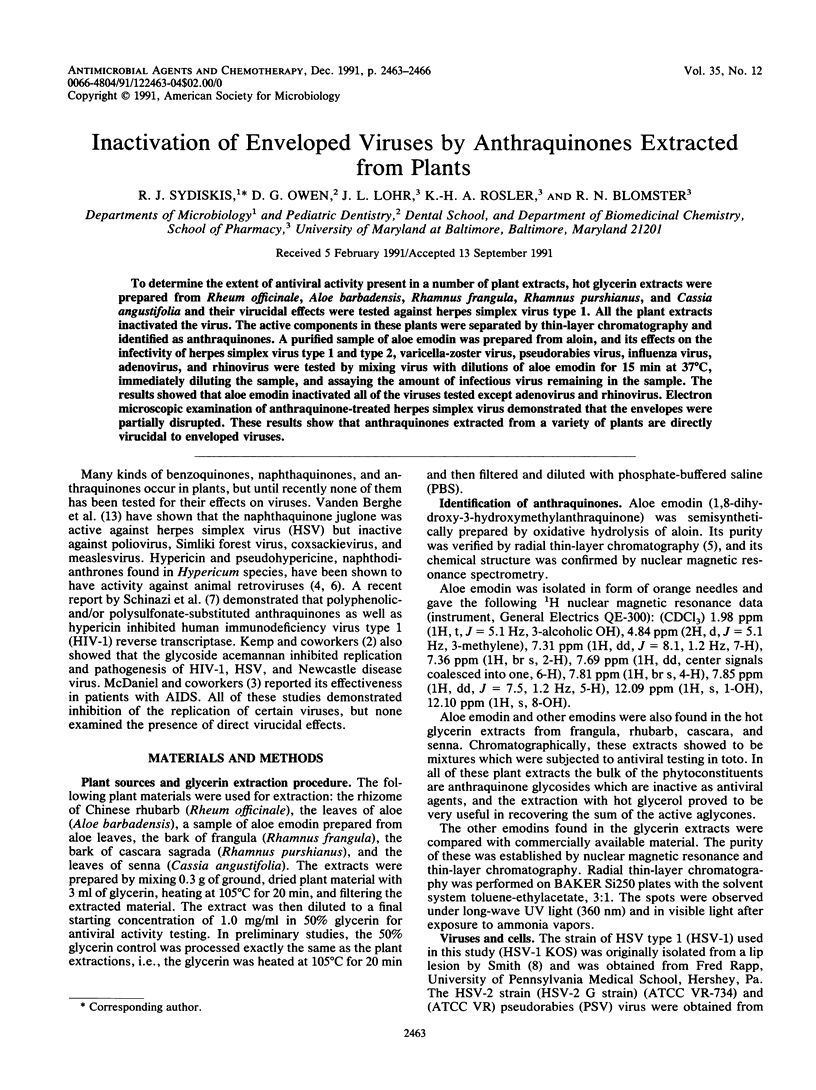Abstract
To determine the extent of antiviral activity present in a number of plant extracts, hot glycerin extracts were prepared from Rheum officinale, Aloe barbadensis, Rhamnus frangula, Rhamnus purshianus, and Cassia angustifolia and their virucidal effects were tested against herpes simplex virus type 1. All the plant extracts inactivated the virus. The active components in these plants were separated by thin-layer chromatography and identified as anthraquinones. A purified sample of aloe emodin was prepared from aloin, and its effects on the infectivity of herpes simplex virus type 1 and type 2, varicella-zoster virus, pseudorabies virus, influenza virus, adenovirus, and rhinovirus were tested by mixing virus with dilutions of aloe emodin for 15 min at 37 degrees C, immediately diluting the sample, and assaying the amount of infectious virus remaining in the sample. The results showed that aloe emodin inactivated all of the viruses tested except adenovirus and rhinovirus. Electron microscopic examination of anthraquinone-treated herpes simplex virus demonstrated that the envelopes were partially disrupted. These results show that anthraquinones extracted from a variety of plants are directly virucidal to enveloped viruses.
Full text
PDF



Selected References
These references are in PubMed. This may not be the complete list of references from this article.
- Dumsha T. C., Sydiskis R. J. Cytotoxicity testing of a dentin bonding system. Oral Surg Oral Med Oral Pathol. 1985 Jun;59(6):637–641. doi: 10.1016/0030-4220(85)90195-1. [DOI] [PubMed] [Google Scholar]
- Meruelo D., Lavie G., Lavie D. Therapeutic agents with dramatic antiretroviral activity and little toxicity at effective doses: aromatic polycyclic diones hypericin and pseudohypericin. Proc Natl Acad Sci U S A. 1988 Jul;85(14):5230–5234. doi: 10.1073/pnas.85.14.5230. [DOI] [PMC free article] [PubMed] [Google Scholar]
- SMITH K. O. RELATIONSHIP BETWEEN THE ENVELOPE AND THE INFECTIVITY OF HERPES SIMPLEX VIRUS. Proc Soc Exp Biol Med. 1964 Mar;115:814–816. doi: 10.3181/00379727-115-29045. [DOI] [PubMed] [Google Scholar]
- Schinazi R. F., Chu C. K., Babu J. R., Oswald B. J., Saalmann V., Cannon D. L., Eriksson B. F., Nasr M. Anthraquinones as a new class of antiviral agents against human immunodeficiency virus. Antiviral Res. 1990 May;13(5):265–272. doi: 10.1016/0166-3542(90)90071-e. [DOI] [PubMed] [Google Scholar]
- Spring S. B., Roizman B. Herpes simplex virus products in productive and abortive infection. I. Stabilization with formaldehyde and preliminary analyses by isopycnic centrifugation in CsCl. J Virol. 1967 Apr;1(2):294–301. doi: 10.1128/jvi.1.2.294-301.1967. [DOI] [PMC free article] [PubMed] [Google Scholar]
- Sydiskis R. J. Compartmentalization of pseudorabies virus and subvirion components in BHK-21 cells and in the extracellular fluid. J Virol. 1970 Sep;6(3):280–285. doi: 10.1128/jvi.6.3.280-285.1970. [DOI] [PMC free article] [PubMed] [Google Scholar]
- Sydiskis R. J. Precursor Products Found in Formaldehyde-fixed Lysates of BHK-21 Cells Infected with Pseudorabies Virus. J Virol. 1969 Sep;4(3):283–291. doi: 10.1128/jvi.4.3.283-291.1969. [DOI] [PMC free article] [PubMed] [Google Scholar]


